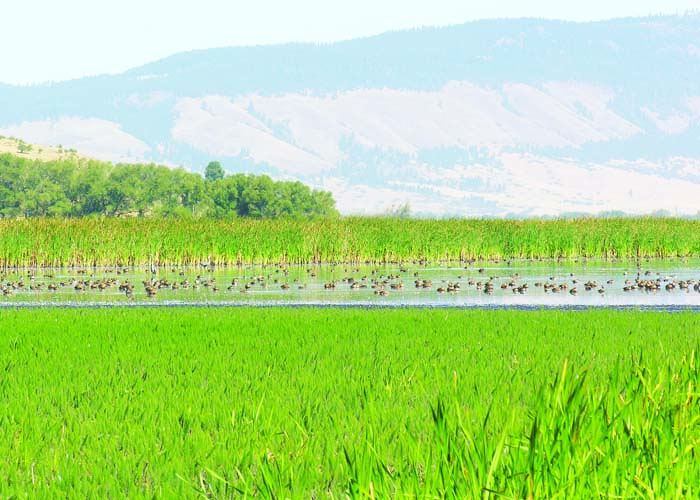Duck hunting workshop Oct. 28-29 near La Grande
Published 5:44 am Thursday, October 12, 2023

- Ladd Marsh near La Grande is a popular spot for hunting waterfowl and upland game birds.
LA GRANDE — A two-day workshop for adults interested in learning about duck hunting is set for Oct. 28-29 near La Grande.
The first day, Duck Hunting 101, starts with a classroom lecture on regulations, duck biology and habitat, how to find a place to hunt, and tips on calling and equipment. Later in the day, participants will take a waterfowl-specific shotgun skills class at the gun range near La Grande.
The second day features a live, mentored duck hunt at Ladd Marsh.
The cost is $50 per person.
The Oregon Department of Fish and Wildlife (ODFW) will provide all hunting equipment, shotguns and ammunition, and waders. Participants can bring their own shotgun and waders. Those who bring a shotgun must bring their own target ammunition and non-lead duck hunting shells.
Participants will need a valid hunting license, waterfowl and HIP validation, federal waterfowl stamp, proper clothing (camo or drab colors highly recommended), food and water, and a cooler with ice.
To register, go to myodfw.com. Click on “Workshops & Events” at the top of the page, then scroll down to “Learn to Hunt — Adult Mentor Duck Hunting Workshop — La Grande.”
Waterfowl hunting forecast
According to the Oregon Department of Fish and Wildlife, population surveys showed a mixed bag for ducks this spring. Populations were up in western Oregon and down in Eastern Oregon. This was not unexpected, as three consecutive years of drought has led to poor production the past few years.
However, habitat conditions were much improved due to excellent snowpack, and biologists have noted good numbers of duck broods throughout Eastern Oregon.
Similarly for geese, most populations, including cackling, Taverners, dusky and white-fronted geese were down substantially from last year. However, biologists are reporting excellent production of goslings this summer.
As usual, hunting success will be dependent on bird numbers and habitat conditions this fall and winter. Early in the season, those areas with good habitat conditions should provide excellent hunting opportunities for locally produced birds, as well as early migrants like wigeon, green-winged teal and pintails.
East of the Cascades, hunters will find better conditions than last year but many large wetland basins were still partially dry this summer, even after excellent precipitation last winter.
Waterfowl hunters should be aware that Highly Pathogenic Avian Influenza (avian flu) was prevalent in Oregon and across the continent last fall and winter in wild waterfowl. While this disease does not present a significant health concern for humans, hunters should practice some routine hygiene precautions whenever handling wildlife. These measures also will help protect from avian flu or any other disease the bird could be carrying:
• Wear rubber or latex gloves when handling and cleaning game birds.
• Do not eat, drink, smoke or touch your face when handling birds.
• Keep the uncooked game bird and any fluid material associated with it away from other foods.
• Thoroughly clean knives and any other equipment or surfaces that come in contact with uncooked birds. A good cleanser and sanitizer is a commercial chlorine-based cleaning solution or mix one third cup of chlorine bleach per one gallon of water.
• Wash your hands with soap and water for at least 20 seconds after handling birds (or with alcohol-based hand products if your hands are not visibly soiled).
• Cook all game meat thoroughly (up to at least 165° F) to kill disease organisms and parasites. Use a food thermometer to ensure the breast or thigh meat has reached at least 165° F.
Waterfowl hunting forecasts Umatilla and Morrow counties
Hunting prospects depend on weather conditions. If the region does not experience a real winter, many of the northern migrants will stay in Washington. The best hunting is usually later in the season (late November) after some weather pushes birds down northern areas. The Columbia River is usually the best opportunity for hunters on public land, but those who can access irrigated circles in northern Morrow County usually get good goose hunting.
Habitat in the Columbia Basin still supports large numbers of wintering Canada geese and the number of snow geese wintering in this area has greatly increased in recent years. Waterfowl hunters should not forget about the Columbia Basin Wildlife Areas (Power City, Irrigon, Coyote Springs, Willow Creek). Food crops were planted and ponds have been enhanced, all of which will make conditions better for waterfowl hunting.
The Columbia basin wildlife areas typically start seeing ducks arrive in waves. The first wave will include teal headed south. Some years the teal have come and gone before the hunting season starts. In mild years the migration may be a little late allowing some teal hunting opportunity. Shortly after that other puddle ducks will start showing up in greater numbers. With the removal of cattails and planting food plots, the wildlife areas are seeing more attention from mallards, gadwall, pintail and small numbers of wood ducks. The largest numbers of mallards seen on the wildlife areas typically occurs during the last few weeks of season. Waterfowl hunting on the wildlife areas are best during very windy conditions when ducks get blown off the Columbia River.
Union County
Duck and goose hunting is expected to be similar to last year. Dry conditions have left fewer broods overall. Early water could make exceptional waterfowl hunting at the start of the season. Limited public lands make Union County difficult to find waterfowl hunting opportunities. Ladd Marsh can be great waterfowl hunting at certain times throughout the season.
Baker County
Duck and goose hunting is expected to be similar to past years with a few resident birds available early in the season. More migrant birds will arrive later in the season and hunting should improve, especially in the Baker and Keating valleys. Almost all hunting is on private property, so be sure to ask permission before hunting. The Powder River from Baker City to Brownlee Reservoir offers the best waterfowl hunting.
Wallowa County
Waterfowl hunting should be similar to previous few years. Expect good hunting opportunities later in the fall and early winter when migrating birds arrive. The few resident Canada geese in the district have fared well, too. Most hunting is decoy hunting in agricultural fields, and jump shooting irrigation ditches so be sure to get landowner permission before hunting.
Grant County
Grant County offers very limited waterfowl hunting opportunities due to lack of habitat — it’s mostly jump shooting on private land along the John Day River. There is some goose hunting along the John Day River on private lands. Be sure to seek permission before hunting.
Harney County
Typically hunting is best in late fall and early winter and on agricultural lands. Be sure to get landowner permission before hunting private lands. Portions of Malheur National Wildlife Area are open to waterfowl hunting (see the Game Bird Hunting Regulations) though hunting success and access to hunting areas is dependent on water levels in Malheur Lake. The North and South Malheur Lake Hunt Zones will both be closed to waterfowl hunting this year due to low water levels.
Duck, snipe, mourning dove hunting zones
• Zone 1: Umatilla, Morrow, Gilliam, Sherman, Wasco counties, all areas west of the Cascades
• Zone 2: All other Eastern Oregon and Central Oregon counties, including Baker, Union, Wallwa, Grant, Masher, Harney, Crook and Wheeler.
Brant: Statewide, Nov. 25-Dec. 10
Daily limit of two birds, possession limit of six
Wilson’s snipe
Zone 1: Nov. 4-Feb. 18, 2024
Zone 2: Oct. 14-Jan. 28, 2024
In both zones, daily limit is eight birds, possession limit is 24
Duck (including merganser)
Zone 1: Oct. 14-29 and Nov. 2-Jan. 28, 2024
Zone 1 scaup: Nov. 4-Jan. 28, 2024
Zone 2: Oct. 14-Dec. 3 and Dec. 7-Jan. 28, 2024
Zone 2 scaup: Oct. 14-Dec. 3 and Dec. 7-Jan. 10, 2024
Coot
Statewide, same seasons as duck, by zone
Daily bag limit for ducks is seven. Within that limit, hunters can’t have more than two scaup, two hen mallards, one pintail, two redheads, and two canvasbacks. The possession limit is triple the daily bag limit. For coot, the daily limit is 25 and the possession limit is 75.
Crow: Oct. 1-Jan. 31, 2024
No daily or possession limits
Goose hunting zones
• Mid-Columbia zone: Umatilla, Morrow, Gilliam, Sherman, Wasco, Hood River counties
• High Desert and Blue Mountains zone: Baker, Union, Wallowa, Masher, Grant, Harney, Lake, Crook, Wheeler, Jefferson, Deschutes, Klamath counties
High Desert and Blue Mountains zone
Canada goose
Oct. 14-Dec. 3 and Dec. 12-Jan. 28, 2024
Daily limit four birds, possession limit 12.
High Desert and Blue Mountains zone
White and white-fronted goose
Oct. 14-Dec. 3 and Jan. 17-March 10, 2024
Daily limits: 10 white-fronted, 20 white, possession limits 30 white-fronted, 60 white
Mid-Columbia zone
Canada goose
Oct. 14-Oct. 29 and Nov. 7-Jan. 28, 2024
Daily limit four birds, possession limit 12.
Mid-Columbia zone
White and white-fronted goose
Nov. 7-Jan. 28, 2024 and Feb. 3-Feb. 24, 2024
Daily limits: 10 white-fronted, 20 white, possession limits 30 white-fronted, 60 white
Note: From Jan. 31-March 10, 2024, goose hunting is closed on the Miller Island Unit of Klamath WA, Summer Lake WA, Ladd Marsh WA, and all units of the Klamath NWR Complex, except for hunters participating in the Veterans and Active Military Personnel Waterfowl Hunt.




